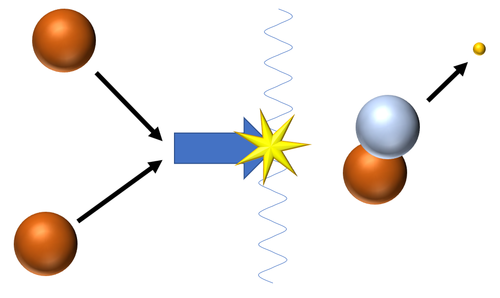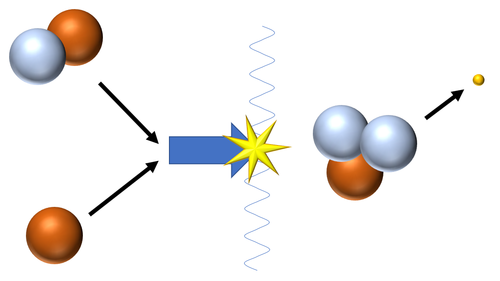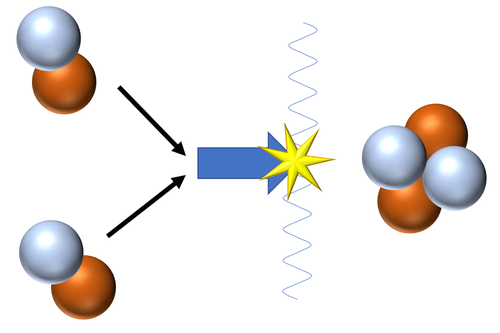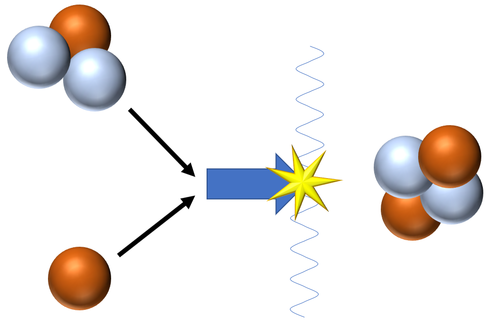Nuclear Fusion
Contents
Key Stage 4
Meaning
Nuclear fusion is a process in which two small atomic nuclei join together to become a larger nucleus.
About Nuclear Fusion
- In a nuclear fusion reaction the products have less mass than the reactants as some of the mass is converted into energy in the process due to the Mass-Energy Equivalence.
- For a fusion reaction to occur the two nuclei must have enough kinetic energy to overcome the electrostatic force of repulsion between the positively charged nuclei.
- To provide enough kinetic energy to the nuclei the substance must be heated to a temperature of several million degrees Celsius.
- Nuclear fusion occurs naturally in the centre of a Star due to the high temperatures and pressure.
- Nuclear fusion is possible in laboratories on Earth but it cannot be sustained for long periods of time to produce enough energy to be useful as an energy resource.
- Nuclear fusion in laboratories on Earth must be done at much higher temperature than in the centre of Stars because the centre of Stars is a much higher pressure so nuclei collide more often.
Nuclear Fusion Reactions
| Fusion of a Tritium and a Deuterium nucleus produces a Helium nucleus.
\({}_1^2H + {}_1^3H \rightarrow {}_2^4He + {}_0^1n\) This is the most common pathway for nuclear fusion in Stars as the neutron goes on to be captured by a Hydrogen nucleus to become Deuterium or captured by a Deuterium nucleus to become a Tritium nucleus. |
| Fusion of two Hydrogen nuclei (protons) produces a Deuterium nucleus.
\({}_1^1H + {}_1^1H \rightarrow {}_1^2H + {}_{+1}^0\beta\) |
| Fusion of a Hydrogen nucleus (proton) and a Deuterium nucleus produces a Tritium nucleus.
\({}_1^1H + {}_1^2H \rightarrow {}_1^3H + {}_{+1}^0\beta\) |
| Fusion of two Deuterium nuclei produces a Helium nucleus.
\({}_1^2H + {}_1^2H \rightarrow {}_2^4He\) |
| Fusion of a Hydrogen nucleus (proton) and a Tritium nucleus produces a Helium nucleus.
\({}_1^1H + {}_1^3H \rightarrow {}_2^4He\) |
References
AQA
- Nuclear fusion, page 108, GCSE Physics, Hodder, AQA
- Nuclear fusion, page 244, GCSE Chemistry, Hodder, AQA
- Nuclear fusion, pages 106-107, GCSE Physics; Third Edition, Oxford University Press, AQA
- Nuclear fusion, pages 140, 141, 318, GCSE Physics; The Complete 9-1 Course for AQA, CGP, AQA
- Nuclear fusion, pages 187-8, GCSE Combined Science Trilogy 2, Hodder, AQA
- Nuclear fusion, pages 49, 100, GCSE Physics; The Revision Guide, CGP, AQA
- Nuclear fusion; in stars, page 252, GCSE Physics, Hodder, AQA
Edexcel
- Nuclear fusion, page 58, GCSE Physics; The Revision Guide, CGP, Edexcel
- Nuclear fusion, pages 110, 114-115, GCSE Physics, Pearson Edexcel




